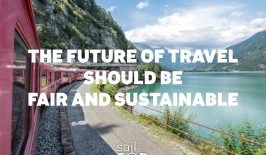The world of marine transportation relies heavily on enormous ships, from cruise liners to containers to giant tankers. One thing each has in common is the use of some of the lowest-quality fuel in the world – bunker fuel – to take them from port to port.
While docked at port, with their main engine switched off, ships still need power for their onboard operations. Many rely on auxiliary generators to supply power to the ship for those needs. But burning bunker fuel has a distrastous impact on air quality, and it’s a particular problem for urban ports located near major cities.
Ships burning fuels for power result in serious air pollution, releasing copious amounts of sulphur dioxide, particulate matter, and nitrous oxides into the surrounding environment. Multiple studies indicate that pollution-belching ships shouldn’t be anywhere near any form of life: a single ship can produce particulate emissions equal to the same amount as 50 million cars annually. It might be somewhat surprising to know that this doesn’t stop while the ships are sitting at port: ports and harbours around the world aren’t yet supplying ships with shore power, so the ships continue have to rely on their own power generators.
Providing shore-to-ship power is the sensible way to “cold-iron” ships, a term used in the industry to explain the process of the ship’s engines cooling down when not needed (originally stemming from iron ships in coal-burning days).
But while it seem like the logical solution, reducing ships’ toxic fuel consumption by providing them with power from the shore isn’t all that easy. There are a whole range of different quirks that currently making it difficult to implement.
Firstly, ships are built in many different shipyards all over the world, meaning they have different power standards, requirements and even plugs – just like when we travel between European countries, or further abroad, and have to take an adaptor with us. Secondly, some ships have only limited power demands, while others, especially passenger cruise ships, may demand huge power loads. Building a capable and flexible power system, able to handle multiple large ships at once, is highly expensive for ports. Funding for high-capacity, reliable grid connections is not a simple task for many ports.
And in addition to all that, even once expensive facilities have been built, there are examples where shore power prices may be much higher than fuel costs during peak periods, which is obviously unattractive to operators.
Among the different approaches to solving this issue comes the Becker LNG PowerPac, from Becker Marine Systems, supported by funding from Germany’s Federal Ministry of Transport and Digital Infrastructure. The PowerPac is a natural gas-powered generator built into two standard-size shipping containers, which can supply power to cold iron container ships, offering 28 – 30 hrs operation at 90% load. It is designed to be loaded onto a ship to supply power directly, via a standard gantry crane.
The original PowerPac supplied up to 1.5 MW of power in testing, with an upgraded 3 MW model tested in the Port of Hamburg within the past week. The advantages of the system are in the flexibility of independent supply at known costs, offering cold ironing or at least a significant reduction of harmful emissions from auxiliary engines from container ships. Becker also offer a larger system designed to supply cruise ships in port, via an LNG Power Barge, which can supply up to 7.5MW of power from five generators. A further model which can supply up to 24MW, or two large ships, has also been prototyped.
The PowerPac project is on its way towards mass production, with the company indicating interest from both European and Chinese ports to supply shore-to-ship power.






